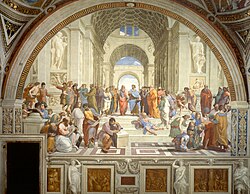| Renaissance |
|---|
 |
| Aspects |
| Regions |
| History and study |

During the Renaissance, great advances occurred in geography, astronomy, chemistry, physics, mathematics, manufacturing, anatomy and engineering. The collection of ancient scientific texts began in earnest at the start of the 15th century and continued up to the Fall of Constantinople in 1453, and the invention of printing allowed a faster propagation of new ideas. Nevertheless, some have seen the Renaissance, at least in its initial period, as one of scientific backwardness. Historians like George Sarton and Lynn Thorndike criticized how the Renaissance affected science, arguing that progress was slowed for some amount of time. Humanists favored human-centered subjects like politics and history over study of natural philosophy or applied mathematics. More recently, however, scholars have acknowledged the positive influence of the Renaissance on mathematics and science, pointing to factors like the rediscovery of lost or obscure texts and the increased emphasis on the study of language and the correct reading of texts.[1][2][3]
Marie Boas Hall coined the term Scientific Renaissance to designate the early phase of the Scientific Revolution, 1450–1630. More recently, Peter Dear has argued for a two-phase model of early modern science: a Scientific Renaissance of the 15th and 16th centuries, focused on the restoration of the natural knowledge of the ancients; and a Scientific Revolution of the 17th century, when scientists shifted from recovery to innovation.
- ^ Rose, Paul Lawrence (1973). "Humanist Culture and Renaissance Mathematics: The Italian Libraries of the Quattrocento". Studies in the Renaissance. 20: 46–105. doi:10.2307/2857013. ISSN 0081-8658. JSTOR 2857013.
- ^ Anglin, W. S.; Lambek, J. (1995), Anglin, W. S.; Lambek, J. (eds.), "Mathematics in the Renaissance", The Heritage of Thales, Undergraduate Texts in Mathematics, New York, NY: Springer, pp. 125–131, doi:10.1007/978-1-4612-0803-7_25, ISBN 978-1-4612-0803-7, retrieved 2021-04-09
- ^ Jayawardene, S. A. (June 1978). "The Italian Renaissance of Mathematics: Studies on Humanists and Mathematicians from Petrarch to Galileo. Paul Lawrence Rose". Isis. 69 (2): 298–300. doi:10.1086/352043. ISSN 0021-1753.